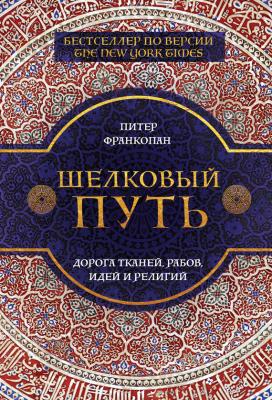Шелковый путь. Дорога тканей, рабов, идей и религий. Питер Франкопан
Читать онлайн.| Название | Шелковый путь. Дорога тканей, рабов, идей и религий |
|---|---|
| Автор произведения | Питер Франкопан |
| Жанр | Прочая образовательная литература |
| Серия | Путешественники во времени |
| Издательство | Прочая образовательная литература |
| Год выпуска | 2015 |
| isbn | 978-5-699-95706-4 |
283
S. Beal, Buddhist Records of the Western World (New Delhi, 1969), рр. 44–46.
284
G. Mitchell and S. Johar, ‘The Maratha Complex at Ellora’, Modern Asian Studies 28.1 (2012), рр. 69–88.
285
Раскопки и исследования были проведены в 1970-х годах командами из Японии и Афганистана, см. T. Higuchi, Japan-Afghanistan Joint Archaeological Survey 1974, 1976, 1978 (Kyoto, 1976–1980).
286
О датировании комплекса Бамиан с 600 года, см. D. Klimburg-Salter, ‘Buddhist Painting in the Hindu Kush c. VIIth to Xth Centuries: Reflections of the Co-existence of Pre-Islamic and Islamic Artistic Cultures during the Early Centuries of the Islamic Era’, in E. de la Vaissière, Islamisation de l’Asie Centrale: processus locaux d’acculturation du VIIe au XIe siècle (Paris, 2008), рр. 140–142; также см. F. Flood, ‘Between Cult and Culture: Bamiyan, Islamic Iconoclasm, and the Museum’, Art Bulletin 84.4 (2002), р. 641ff. Информация есть также здесь L. Morgan, The Buddhas of Bamiyan (London, 2012).
287
Цитируется по Power, Red Sea, р. 58.
288
I. Gillman and H. – J. Klimkeit, Christians in Asia before 1500 (Ann Arbor, 1999), рр. 265–305.
289
G. Stroumsa, Barbarian Philosophy: The Religious Revolution of Early Christianity (Tübingen, 1999), рр. 80, 274–281.
290
J. Choksy, ‘Hagiography and Monotheism in History: Doctrinal Encounters between Zoroastrianism, Judaism and Christianity’, Islam and Christian-Muslim Relations 14.4 (2010), рр. 407–421.
291
Pseudo-Dionysius of Tel Mahre, Chronicle (Known Also as the Chronicle of Zuqnin), Part III, tr. W. Witaksowski (Liverpool, 1996), р. 77.
292
Procopius, Hyper ton polemon, 2.22–3, in History of the Wars, Secret History, Buildings, ed. and tr. H. Dewing, 7 vols (Cambridge, MA), 1, рр. 450–472.
293
M. Morony, ‘“For Whom Does the Writer Write?”: The First Bubonic Plague Pandemic According to Syriac Sources’, in K. Lester (ed.), Plague and the End of Antiquity: The Pandemic of 541–750 (Cambridge, 2007), р. 64; D. Twitchett, ‘Population and Pestilence in T’ang China’, in W. Bauer (ed.), Studia Sino-Mongolica (Wiesbaden, 1979), 42, р. 62.
294
Р. Sarris, Economy and Society in the Age of Justinian (Cambridge, 2006); также ‘Plague in Byzantium: The Evidence of Non-Literary Sources’, in Lester, Plague and the End of Antiquity, рр. 119–134; A. Cameron, The Mediterranean World in Late Antiquity: AD 395–700 (London, 1993), р. 113ff; D. Stathakopoulos, Famine and Pestilence in the Late Roman and Early Byzantine Empire: A Systematic Survey of Subsistence Crises and Epidemics (Birmingham, 2004), рр. 110–165.
295
Sarris, Empires of Faith, р. 145ff.
296
Procopius, The Secret History, tr. Р. Sarris (London, 2007), р. 80.
297
John of Ephesus, Ecclesiastical History, 6.24, tr. R. Р. Smith (1860), р. 429.
298
M. – T. Liu, Die chinesischen Nachrichten zur Geschichte der Ost-Türken (T’u-küe), 2 vols (Wiesbaden, 2009), 1, р. 87. Также см. J. Banaji, ‘Precious-Metal Coinages and Monetary Expansion in Late Antiquity’, in F. De Romanis and S. Sorda (eds), Dal denarius al dinar: l’oriente e la monetà romana (Rome, 2006), рр. 265–303.
299
The History of Menander the Guardsman, tr. R. Blockley (Liverpool, 1985), р. 121–123.
300
Там же, рр. 110–117.
301
Sarris, Empires of Faith, рр. 230–231.
302
Menander the Guardsman, рр. 173–175.
303
Об источниках см. Greatrex and Lieu, Roman Eastern Frontier, Part II, рр. 153–158.
304
R. Thomson, The Armenian History Attributed to Sebeos. Part I: Translation and Notes (Liverpool, 1999), 8, р. 9.
305
Agathias, Historion, 2.24, р. 72.
306
G. Fisher, ‘From Mavia to al-Mundhir: Arab Christians and Arab Tribes in the Late Antique Roman East’, in I. Toral-Niehoff and K. Dimitriev (eds), Religious Culture in Late Antique Arabia (Leiden, 2012), р. x; M. Maas, ‘“Delivered from their Ancient Customs”: Christianity and the Question of Cultural Change in Early Byzantine Ethnography’, in K. Mills and A. Grafton (eds), Conversion in Late Antiquity and the Early Middle Ages (Rochester, NY, 2003), рр. 152–188.
307
R. Hoyland, ‘Arab Kings, Arab Tribes and the Beginnings of Arab Historical Memory in Late Roman Epigraphy’, in H. Cotton, R. Hoyland, J. Price and D. Wasserstein (eds), From Hellenism to Islam: Cultural and Linguistic Change in the Roman Near East (Cambridge, 2009), рр. 374–400.
308
M. Whittow, ‘Rome and the Jafnids: Writing the History of a Sixth-Century Tribal Dynasty’, in J. Humphrey (ed.), The Roman and Byzantine Near East: Some Recent Archaeological Research (Ann Arbor, 1999), рр. 215–233.
309
K. ʿAtahmina, ‘The Tribal Kings in Pre-Islamic Arabia: A Study of the Epithet malik or dhū al-tāj in Early Arabic Traditions’, al-Qanṭara 19 (1998), р. 35; M. Morony, ‘The Late Sasanian Economic Impact on the Arabian Peninsula’, Nāme-ye Irān-e Bāstān 1.2 (201/2), рр. 35–36; I. Shahid, Byzantium and the Arabs in the Sixth Century, 2 vols (Washington, DC, 1995–2009), 2.2, рр. 53–54.
310
Sarris, Empires of Faith, рр. 234–236.
311
Procopius,
